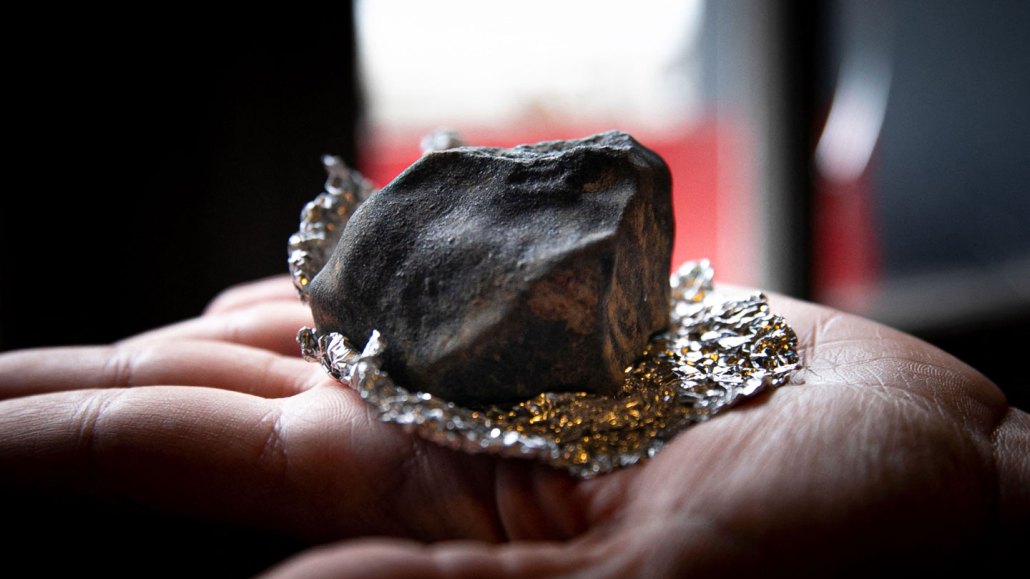Let’s learn about meteorites
Meteorites are bits of the moon, Mars, asteroids, comets or other space rocks that have landed on Earth

This meteorite came from an asteroid named 2023 CX1. The bit of asteroid rubble was found in February 2023 in northwestern France.
LOU BENOIST/Contributor/AFP/Getty Images
Share this:
- Share via email (Opens in new window) Email
- Click to share on Facebook (Opens in new window) Facebook
- Click to share on X (Opens in new window) X
- Click to share on Pinterest (Opens in new window) Pinterest
- Click to share on Reddit (Opens in new window) Reddit
- Share to Google Classroom (Opens in new window) Google Classroom
- Click to print (Opens in new window) Print
Except for a handful of manned missions to the moon, people have seen celestial bodies only from afar. But sometimes, bits of those far-off space rocks crash onto Earth. We call these rogue bits of space rubble meteorites. And they offer rare, handheld samples of the materials that make up distant places in the solar system.
Some meteorites are bits of asteroids or comets. Others are pieces of debris that were blasted off the moon or Mars by asteroid or comet impacts. Still others may have come from planets that no longer exist.
Some 44 metric tons (nearly 50 U.S. tons) of space rock are thought to hit Earth each day. Almost all of it burns up in the atmosphere. Still, tens of thousands of meteorites larger than marbles are thought to land on Earth each year. They can be hard to find, though, amongst all the other rocky bits on our planet. That’s why some scientists search for them in the flat, white terrain of Antarctica.
Many meteorites consist of rock leftover from the early solar system. (Due to Earth’s plate tectonics, much of the rock on our own planet is much younger.) That means meteorites can offer clues about our solar system’s history. They can also hint at whether other places in our solar system have hosted the right conditions for life in the past.
Earth isn’t the only planet that gets pelted with space rocks. Mercury, for instance, may be coated in diamond, thanks to meteorites bombarding its surface. The solar system is a pretty violent place. So while it might be cool to find more meteorites lying around, it’s probably best that our atmosphere shields us from most rocks raining down from space.
Want to know more? We’ve got some stories to get you started:
Hot on the trail of Antarctic meteorites Each year, scientists scour the frozen continent for space rocks. (1/11/2018) Readability: 7.1
Mercury’s surface may be studded with diamonds Meteorites may have turned much of the planet’s graphite crust into precious gemstones. (4/20/2022) Readability: 7.9
No, organic molecules alone don’t point to life on Mars Organic molecules in a meteorite from Mars were probably not made by alien life — but could still help scientists investigate whether life is possible on other planets. (2/9/2022) Readability: 6.9
Explore more
Scientists Say: Asteroid, meteor and meteorite
Let’s learn about meteor showers
Diamonds and more suggest unusual origins for asteroids
A meteor explodes over Michigan
Scientists discover likely source of the moon’s faint yellow tail
Meteorites may be excavating lunar water
Diamonds and more suggest unusual origins for asteroids
Early solar system may have slung giant mud balls
Jupiter may be the solar system’s oldest planet
Caught on camera: A small rock hit the moon
Activities
Meteorites come in a huge variety of shapes, sizes — and sometimes sparkles! Take a virtual tour of the American Museum of Natural History’s meteorite collection to see some of the diversity in space rocks that have fallen to Earth.






